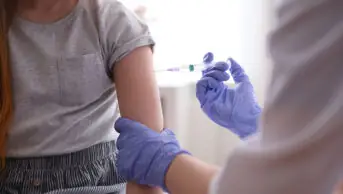
Shutterstock.com
Community pharmacists in England have recorded administering 2.6 million flu vaccines as part of the NHS advanced service in 2020–2021 — over 1 million more than were administered by community pharmacy during the previous flu season.
According to statistics published by the Pharmaceutical Services Negotiating Committee (PSNC), pharmacies using Sonar and PharmOutcomes administered a total of 2,617,566 as of 30 March 2021 — one day before the end of the annual programme.
This is compared with the 1,524,753 administered in 2019–2020.
However, pharmacy negotiators have said the true total figure for 2020–2021 may be closer to 3 million as the data provided by the IT systems “slightly undercounts the actual numbers of people vaccinated by pharmacies”.
The increase in vaccinations follows an expansion in the number of patients eligible for free flu vaccines in 2020–2021 to include people aged 50–64 years, households of those on the shielded patient list, and children in the first year of secondary schools.
To cope with the added demand, community pharmacies were able to order additional stocks of flu vaccine from centralised government supplies as of 2 November 2020.
But Rekha Shah, lead for vaccinations at Pharmacy London, said the ordering system was “a veritable shambles” and community pharmacy “could have definitely … vaccinated more of the eligible cohorts last year had they not experienced the terribly inefficient and unfair distribution of the DHSC [Department of Health and Social Care] procured vaccine stocks”.
“Community pharmacies had to pay for the stock up front with the condition it was not returnable should they not use it all, which meant they could be out of pocket and so would need to order smaller amounts as needed,” Shah explained.
“This resulted in community pharmacies [being] unable to meet expectations of the public once the vaccination of the 50 to 64 cohort opened up,” she said, adding that this meant pharmacies had to “turn people away” initially.
“I know many pharmacies in London have excess stock that they had purchased from this additional DHSC-procured vaccine stock that has not been able to be used up, because it came so late or the expected numbers could not be vaccinated, and this has left them with a cost to their bottom line,” Shah continued.
Commenting on the vaccination numbers, Simon Dukes, chief executive of the PSNC, said the growth in provision was “nothing short of phenomenal”.
With 4 million additional patients vaccinated against the flu overall in 2020–2021, Dukes said the additional 1 million from pharmacy services “represents about 25% of the overall growth in the flu vaccination programme this season — far more than our usual share of around 10–12% of the total programme”.
“It shows just how committed pharmacies are to their patients, finding innovative ways of working, and delivering on NHS priorities in very challenging circumstances,” he said.
Mark Lyonette, chief executive of the National Pharmacy Association, said the delivery of 2.6 million flu vaccines “during a most unsettled year, is a huge testament to pharmacy teams and their willingness to get the job done”.
“Vaccinations are now a firmly established aspect of community pharmacy’s public health role, alongside support for behavioural change and health monitoring of various kinds,” he added.
“The flu vaccination programme has once again shown the importance of having an accessible network of pharmacies operating close to where people live, work and shop.”


